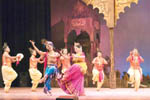Ganga-Jamuna Theatre Festival
Nrityanchal stages Rai-Krishna Padabali
 Radha’s grief over Krishna’s absence and her wistful longing for his return in the dance drama Rai-Krishna Padabali touched the hearts of the audience at the National Theatre Hall of Bangladesh Shilpakala Academy on Wednesday evening. The viewers were also enchanted by the performances of over 40 dancers; especially by the remarkable chemistry that noted dancers Shibli Mohammad and Shamim Ara Nipa shared, playing Krishna and Radha respectively.
Radha’s grief over Krishna’s absence and her wistful longing for his return in the dance drama Rai-Krishna Padabali touched the hearts of the audience at the National Theatre Hall of Bangladesh Shilpakala Academy on Wednesday evening. The viewers were also enchanted by the performances of over 40 dancers; especially by the remarkable chemistry that noted dancers Shibli Mohammad and Shamim Ara Nipa shared, playing Krishna and Radha respectively.
Dance school Nrityanchal staged the dance drama titled Rai-Krishna Padabali at the ongoing eight-day Ganga-Jamuna Theatre Festival 2014, which is organised by Ganga-Jamuna Nattya Utsab Parshad.
Rai-Krishna Padabali has been adapted by poet Sheikh Hafizur Rahman from Rabindranath Tagore’s Bhanusingher Padabali, which is a collection of songs penned by the Nobel laureate.
Directed by Sukalyan Bhattacharya, the play depicts the romantic saga of the epic love story of Radha and Krishna.
Radha’s lamentations and restlessness when Krishna moves to Mathura, a neighboring state, for maintaining his kingdom, occupies most of the play. Nipa wowed the audiences by her impeccable portrayal of Radha. She dances with all her heart covering the full stretch of the stage with great vigor and passion. Nipa successfully depicted the different nuances of the intense emotions that Radha feels, which had the audiences present at the show transfixed.
Krishna’s comeback to Brindaban also served as his introduction in the play. Krishna’s entrance seemed majestic on stage as he entered in a royal chariot pulled by four horses, which was replicated beautifully by the artistes of Nrityanchal. The chariot scene transported the 21st century audiences back to the ancient Indian era in the blink of an eye.
Radha-Krishna’s reunion turned out to be a happy moment for the audiences as well. The duo ended the drama with delightful dances in celebration of their love.
Rai-Krishna Padabali was premiered by Nrityanchal on February 24, 2012 as a tribute to Tagore on his 150th birth anniversary.
-With New Age input




















